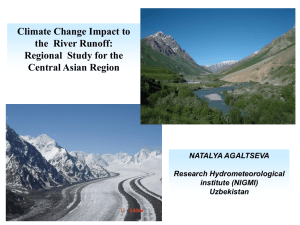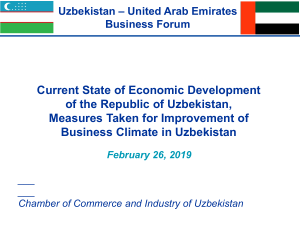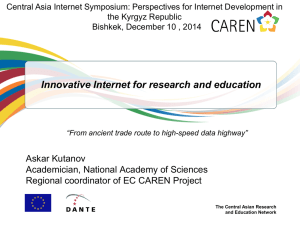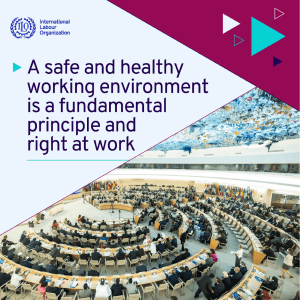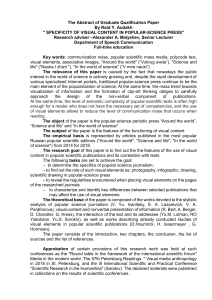7614-international-watercourses-international-water-law-and-central-asia
реклама
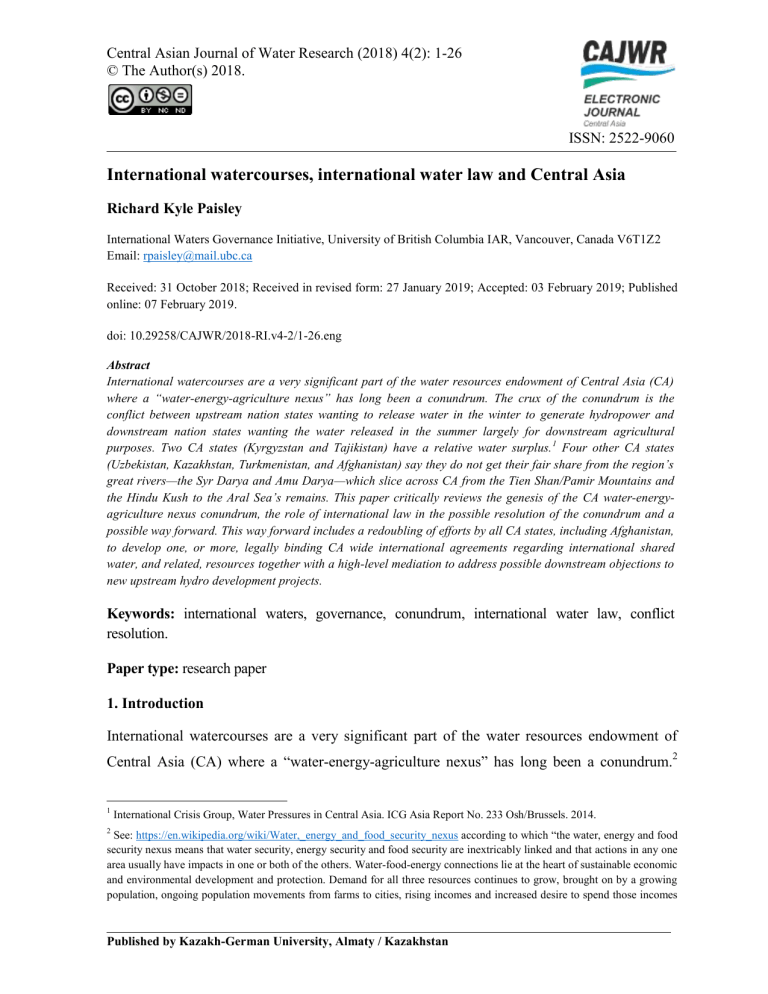
Central Asian Journal of Water Research (2018) 4(2): 1-26 © The Author(s) 2018. ISSN: 2522-9060 International watercourses, international water law and Central Asia Richard Kyle Paisley International Waters Governance Initiative, University of British Columbia IAR, Vancouver, Canada V6T1Z2 Email: [email protected] Received: 31 October 2018; Received in revised form: 27 January 2019; Accepted: 03 February 2019; Published online: 07 February 2019. doi: 10.29258/CAJWR/2018-RI.v4-2/1-26.eng Abstract International watercourses are a very significant part of the water resources endowment of Central Asia (CA) where a “water-energy-agriculture nexus” has long been a conundrum. The crux of the conundrum is the conflict between upstream nation states wanting to release water in the winter to generate hydropower and downstream nation states wanting the water released in the summer largely for downstream agricultural purposes. Two CA states (Kyrgyzstan and Tajikistan) have a relative water surplus. 1 Four other CA states (Uzbekistan, Kazakhstan, Turkmenistan, and Afghanistan) say they do not get their fair share from the region’s great rivers—the Syr Darya and Amu Darya—which slice across CA from the Tien Shan/Pamir Mountains and the Hindu Kush to the Aral Sea’s remains. This paper critically reviews the genesis of the CA water-energyagriculture nexus conundrum, the role of international law in the possible resolution of the conundrum and a possible way forward. This way forward includes a redoubling of efforts by all CA states, including Afghanistan, to develop one, or more, legally binding CA wide international agreements regarding international shared water, and related, resources together with a high-level mediation to address possible downstream objections to new upstream hydro development projects. Keywords: international waters, governance, conundrum, international water law, conflict resolution. Paper type: research paper 1. Introduction International watercourses are a very significant part of the water resources endowment of Central Asia (CA) where a ―water-energy-agriculture nexus‖ has long been a conundrum.2 1 International Crisis Group, Water Pressures in Central Asia. ICG Asia Report No. 233 Osh/Brussels. 2014. 2 See: https://en.wikipedia.org/wiki/Water,_energy_and_food_security_nexus according to which ―the water, energy and food security nexus means that water security, energy security and food security are inextricably linked and that actions in any one area usually have impacts in one or both of the others. Water-food-energy connections lie at the heart of sustainable economic and environmental development and protection. Demand for all three resources continues to grow, brought on by a growing population, ongoing population movements from farms to cities, rising incomes and increased desire to spend those incomes Published by Kazakh-German University, Almaty / Kazakhstan 2 The crux of the conundrum is the conflict between upstream nation states wanting to release water in the winter to generate hydropower and downstream nation states wanting the water released in the summer largely for downstream agricultural purposes.3 Two CA states (Kyrgyzstan and Tajikistan) have a relative water surplus.4 Four other CA states (Uzbekistan, Kazakhstan, Turkmenistan, and Afghanistan) say they do not get their fair share from the region’s great rivers—the Syr Darya and Amu Darya—which slice across CA from the Tien Shan/Pamir Mountains and the Hindu Kush to the Aral Sea’s remains.5 See Figure 1. According to a 2014 report of the International Crisis Group political, economic, environmental and social pressures in CA are arguably accelerating especially in Kyrgyzstan, Tajikistan, and Uzbekistan.6 The population in CA has increased by almost 10 million since 2000, and limited arable land is being depleted by overuse and outdated farming methods.7 Extensive corruption and failing infrastructure are increasingly taking a toll and climate change is increasingly likely to have long-term negative consequences throughout CA.8 As various CA economies continue become increasingly weaker, and states more fragile, heightened nationalism, (perceived) religious discrimination and dogmatism, border disputes, and regional tensions increasingly complicate the search for mutually acceptable solutions to the region’s water, energy and related needs.9 on energy and water intensive goods. Irrigated agriculture is the largest user of freshwater, while more than one fourth of energy used worldwide is an input for food production, distribution, and use. Greater capacity to pay for improved water will enable alternative water sources such as desalination to bring water into urban from greater distances such as desalinated seawater often requiring energy-intensive production and transport methods. The unbroken links between these sectors continues to demand well-integrated plans to protect food and water, and food security.‖ See also: Bichsel, Christine. Weaponizing water: water and energy as sources of conflict among the Central Asian soviet successor states. 22 Mich. St. Int’l. L. Rev. 409. 2013. 3 Paisley, Richard Kyle. Winter is Coming: USA Strategic Interests and Addressing the Water- Energy-Agriculture Nexus Conundrum in Central Asia, WWF USA (2017) 4 International Crisis Group, Water Pressures in Central Asia. ICG Asia Report No. 233 Osh/Brussels. 2014. 5 Id. at Executive Summary. 6 Id. 7 Id. 8 Id. 9 Miroslav, Mansur. Are ―Water Wars‖ Imminent in Central Asia? Aljazeera, 23 March 2016. http://www.aljazeera.com/indepth/features/2016/03/water-wars-imminent-central-asia-160321064118684.html (27 July 2016); Bart, Jason, Weaponizing water: water and energy as sources of conflict among the Central Asian Soviet successor states. 22 Mich. St. Int’l. L. Rev. 409. 2013. Central Asian Journal of Water Research (2018) 4(2): 1-26 3 Figure 1. Water Resources of the Aral Sea Basin10 2. Central Asia: basic facts Total area: 1.6 million (M) sq. mi. (larger than India); Kazakhstan: 1.1 M sq. mi.; Kyrgyzstan: 77,000 sq. mi.; Tajikistan: 55,800 sq. mi.; Turkmenistan: 190,000 sq. mi.; Uzbekistan: 174,500 sq. mi.11 Total population: 64.97 M (slightly less than France); Kazakhstan: 17.74 M; Kyrgyzstan: 5.55 M; Tajikistan: 7.91 M; Turkmenistan: 5.11 M; Uzbekistan: 28.66 M.12 Total gross domestic product: US$414.74 billion (B) in 2012 (slightly less than Belgium). Per capita GDP is about US$6,400 (slightly less than Bhutan). There are large income disparities (and relatively large percentages of people in each country are in poverty). Kazakhstan: 10 Paisley, Richard Kyle. Winter is Coming: USA Strategic Interests and Addressing the Water- Energy-Agriculture Nexus Conundrum in Central Asia, WWF USA (2017) 11 Nichol, Jim. Central Asia: Regional Developments and Implications for U.S. Interests, Congressional Research Service, 2014 at 3. 12 July 2013 estimate, The World Factbook. Central Asian Journal of Water Research (2018) 4(2): 1-26 4 US$231.3 B; Kyrgyzstan: US$13.47 B; Tajikistan: US$17.72 B; Turkmenistan: US$47.55 B; Uzbekistan: US$104.7 B13. 3. International law International law is the set of rules that nation states use to manage their relations. International law is different from national law. In a national legal system, a central lawmaking body or legislature generally makes the laws, the executive implements the laws and secures their observance, and the judiciary interprets and applies the laws. Generally speaking, there are no equivalents to these bodies in the international legal system. Nation states accept a rather detailed governance structure as the price of belonging to the international community. States that refuse to do so are increasingly rare, and are usually treated as pariahs. More simply, all States are bound by customary international law whether they have expressly accepted. There is an important distinction to be made between internal, or domestic, law and international law. The former governs nation states’ citizens but the latter does not always. Nation states make the rules that govern their citizens and that apply within the limits of their territorial jurisdiction, including the land within their borders, internal waters, territorial sea and the air above these areas extending to the point at which the legal regime of outer space begins. Each of these territorial areas is defined by legal rules. Areas outside the national jurisdiction of each nation state include the high seas, deep seabed, atmosphere and outer space, and possibly certain limited land areas in Antarctica. These areas are sometimes called the ―global commons‖ and international rules also govern these areas. International law may generally be regarded as being based on the consent of nation States, its principal subjects. International treaties affect only those nation States that consent, or agree, to be legally bound by the written agreement. International law is formed usually when nation States need to cooperate with other nation States. This need to cooperate creates an incentive to comply with international law. However, conditions do change, which can lead to violations of international law. Law-breaking nation States may attract diplomatic pressures, 13 The World Factbook, purchasing power parity Central Asian Journal of Water Research (2018) 4(2): 1-26 5 measures adopted by the U.N. Security Council, sanctions, countermeasures, and in extreme cases, military intervention, responses, some of which may themselves be unlawful. Art. 38(1)(b) of the International Court of Justice Statute describes the law to be applied by the ICJ when deciding cases within its jurisdiction and is generally considered to be the most authoritative enumeration of the sources of International Law. 38(1)(b) 1. The Court, whose function is to decide in accordance with international law such disputes as are submitted to it, shall apply: a. international conventions, whether general or particular, establishing rules expressly recognized by the contesting states; b. international custom, as evidence of a general practice accepted as law; c. the general principles of law recognized by civilized nations; d. subject to the provisions of Article 59, [i.e. that only the parties bound by the decision in any particular case,] judicial decisions and the teachings of the most highly qualified publicists of the various nations, as subsidiary means for the determination of rules of law. The elements of customary international law generally include: a general practice of nation States, usually over time (State practice); the requirement that the conduct in question be engaged in out of a sense of legal obligation (opinio juris); and that the practice be a general one, which has not been rejected by a significant number of nation States. Proof of custom can be difficult (see, e.g., the North Sea Continental Shelf Cases) but Article 38(1)(d) of the ICJ Statute identifies forms of evidence of customary international law. i.e. ―judicial decisions and the teachings of the most highly qualified publicists‖ as ―subsidiary means for the determination of‖ – i.e., as evidence of – ―rules of [customary international] law‖. In 1950, the International Law Commission identified a broader list of possible forms of evidence of customary international law: treaties, decisions of national courts and international tribunals, national legislation, diplomatic correspondence, opinions of national legal advisors, and the practice of international organizations (―Report of the International Central Asian Journal of Water Research (2018) 4(2): 1-26 6 Law Commission to the General Assembly (Part II): Ways and Means of Making the Evidence of Customary International Law More Readily Available,‖ [1950] 2 Y.B. Int’l L. Comm’n 367, ILC Doc. A/1316). Generally speaking, international law governs all aspects of the relations between nation States. Since the establishment of the United Nations in 1945, the international legal system has been concerned first and foremost with the maintenance of international peace and security (UN Charter, Art. 1(1).). However, the international legal system governs all other facets of inter-State relations including human rights, protection and use of the sea, trade, protection and use of natural resources and the environment, and international financial regimes and investment. The law and how it is applied are influenced by such factors as poverty; human health; the North-South divide; and excessive and inequitable consumption patterns. In the field of international law it can be useful to distinguish between ―hard‖ law and ―soft‖ law. Hard law generally consists of binding norms. In comparison, ―soft‖ law is not binding. However, soft law is increasingly important in the development of international law. As discussed below, soft law may be found in instruments that are themselves not binding, such as declarations adopted by the U.N. General Assembly or conferences of States. In the field of the environment, soft law has been of central importance. The 1972 Stockholm Declaration and the 1992 Rio Declaration are soft law instruments, yet they have established expectations of conduct on the part of nation States and have thus prepared the path for the development of the law. Principle 21 of the Stockholm Declaration and its counterpart in the Rio Declaration, Principle 2, have been particularly influential, and have probably become customary norms. (See, e.g., the Indus Waters Kishenganga Arbitration (Pakistan v. India), and the Pulp Mills on the River Uruguay case, I.C.J. Reports 2010, p. 14.) Soft law has sometimes been called more flexible, dynamic, and democratic than hard law. Soft law creation does not depend on formal negotiations between authorized diplomats. Soft law can be initiated or substantially influenced by NGOs, and international institutions, such as the United Nations Environment Programme. Different groupings of States can also significantly affect soft law development, as in the case of the Organization for Economic Central Asian Journal of Water Research (2018) 4(2): 1-26 7 Cooperation and Development (OECD) and the looser groupings of developing countries within the United Nations. Hard law generally includes conventions, treaties, agreements and protocols. These are all different names for the same thing i.e. legally binding written agreements between States. In the field of international environmental law, treaties, which usually take the form of Multilateral Environmental Agreements (MEAs), set forth what may be thought of as international legislation in the field of the environment. For example, the Convention on Biological Diversity has 196 parties, including Afghanistan, more than the number of members of the United Nations (193). Thus, virtually all nations in the world are bound by this treaty, giving it a ―legislative‖ effect. Treaties may codify existing and emerging norms or create new binding rules. The 1969 Vienna Convention on the Law of Treaties14 is generally accepted as a codification of the rules of customary international law on treaties. The Vienna Convention on the Law of Treaties defines what a treaty is (Part 1), and sets forth rules for the conclusion and entry into force of treaties (Part 2), their observance, application and interpretation (Part 3), their amendment and modification (Part 4), and their invalidity, termination and suspension of operation (Part 5). Soft law refers to documents like declarations, guidelines, resolutions and statements of principle or codes of conduct that are not legally binding. It includes United Nations General Assembly resolutions, conference declarations—such as the 1972 Stockholm Declaration on the Human Environment and the 1992 Rio Declaration on Environment and Development— and statements from major United Nations bodies. Some observers would also classify statements from major NGOs, such as the IUCN and WWF as being a form of soft law. Soft law is becoming more common internationally. Soft law instruments may also lay the foundation for later legally binding agreements. For example, the 1989 UNEP-FAO Prior Informed Consent (PIC) guidelines for certain toxic chemicals and pesticides led to the 1998 Rotterdam Prior Informed Consent (PIC) Convention and the FAO’s 1983 International 14 Vienna Convention on the Law of Treaties, Vienna, 23 May 1969, 1155 UNTS 331 Central Asian Journal of Water Research (2018) 4(2): 1-26 8 Undertaking on Plant Genetic Resources led to the adoption of the 2001 International Treaty on Plant Genetic Resources for Food and Agriculture. Though soft law generally creates aspirational goals rather than strict legal duties, this is not always the case. On occasion, a non-binding document is so precise and detailed that it could easily be mistaken for a treaty—an example is the OECD Guidelines for Multinational Enterprises, revised in 2011. As the Foreword from the OECD Secretary General states: the Guidelines are an example of the type of multilateral instrument that will be used more and more in future to set rules, which, though not formally legally binding, are meant to work, be implemented, followed up and monitored. Again, though not formally binding legally, such instruments can create expectations that nation States will follow them. Whether States and others comply with soft law commitments in the same manner as they do binding treaty law remains a subject of debate. Initial research findings suggest that soft law compliance is more likely when the soft law instruments are linked to binding international agreements or to existing regional and national legal arrangements. However, this does not change the fact that soft law is often a precursor of hard law. It often constitutes what might be thought of as a moral obligation that States try to adhere to. 4. International water law International water law relating to the non-navigational uses of international watercourses has traditionally suffered from uncertainty. First, a number of conflicting theoretical approaches or principles have historically been used to identify and justify the respective rights of riparian nation states regarding the quantity of water that each nation state may extract, and the permissibility of uses, of international watercourses. Second, until relatively recently, there has been relatively little substantive international law on the subject, with concern instead mostly for navigational questions. Third, such international law as had existed tended to be dominated by bilateral and regional treaties, as opposed to multilateral or more widely acceptable agreements.15 15 Paragraph adapted from McIntyre, O. (2007) Environmental Protection of International Watercourses Under International Law. Oxon, GBR: Ashgate Publishing. Central Asian Journal of Water Research (2018) 4(2): 1-26 9 International water law, like international law in general, may take either of two general forms: treaty law or customary international law. If nation states sharing international freshwater resources are not parties to an applicable treaty, their rights and obligations are governed by customary international law. Three separate international agreements predominate: the 1997 UN Watercourses Convention on the Non-Navigational Uses of International Watercourses16; the 1992 UN ECE Convention on the Protection and Use of Transboundary Watercourses and International Lakes17 and the 1966 Helsinki Rules on the Uses of the Waters of International Rivers. The United Nations the 1997 Convention on the Law of the Non-Navigational Uses of International Watercourses (―Watercourses Convention‖) was adopted on 21 May 1997. The purposes of the Watercourses Convention may generally be said to be to regulate the use, development, management, and conservation of all internationally-shared fresh waters, both surface water and groundwater. The Watercourses Convention entered into force on August 17, 2014. As of February 2017, the Watercourses Convention had a total of 16 signatories and 36 member States. The Watercourses Convention is a framework convention that lays down basic principles and procedures and leaves the details to be worked out by member States taking into account the specifics and characteristics of their shared river basins. Some of the member countries include the United Kingdom, France, Germany, Denmark, Sweden, and Hungry (Europe), Iraq, Jordan, Lebanon, Syria and Qatar (Middle East), as well as Uzbekistan (Central Asia). The Watercourses Convention is a flexible and overarching global legal framework that establishes basic standards and rules for cooperation between watercourse states on the use, management, and protection of international watercourses. The Watercourses Convention represents the most authoritative codification of international water law. Its entry into force in 2014 provides additional legitimacy to the customary principles and rules of international water law that are codified in the Watercourses Convention, including the general duty to cooperate and its expression through various specific cooperation obligations. The 1992 UN ECE Convention on the Protection and Use of Transboundary Watercourses and International Lakes was adopted in Helsinki in 1992 and entered into force in 1996. The 16 17 36 ILM 700 (1997); G.A. Res. 51/229, U.N. GAOR, 51st Sess., 99th mtg., UN Doc A/RES/51/229 (1997) 1936 UNTS 269; 31 ILM 1312 (1992) Central Asian Journal of Water Research (2018) 4(2): 1-26 10 Convention strengthens transboundary water cooperation and measures for the ecologicallysound management and protection of transboundary surface waters and groundwaters. In 2003, the Convention was amended to allow accession by countries outside the UNECE region. The amendment entered into force on 6 February 2013, turning the Convention into a legal framework for transboundary water cooperation worldwide. The seminal 1966 Helsinki Rules are of particular historical importance and are further discussed below. The Watercourses Convention defines the term ―watercourse‖ and ―international watercourse‖ as follows: “Watercourse” means a system of surface waters and ground waters constituting by virtue of their physical relationship a unitary whole and normally flowing into a common terminus. “International Watercourse” means a watercourse, parts of which are situated in different States. The breadth of these definitions means that the rules of international law concerning shared freshwater apply to any, and all, ―parts‖ of an international watercourse that may be located in a given country. Thus, they would apply to: e.g. Headwaters or tributaries in State A of a stream that flows into State B; e.g. A groundwater basin that straddles the border between States A and B and is fed by and/or feeds into surface water in State A; e.g. A groundwater basin wholly located in State A that feeds a tributary of a stream flowing into State B. 4.1. General rules of law concerning the use of international watercourses There are several rules of international law of a general and fundamental nature that govern the conduct of nation States in relation to international watercourses. The most basic of these are the following requirements: A State that uses an international watercourse has a general ―duty to cooperate‖ with the other States sharing the watercourse (―watercourse States‖); Central Asian Journal of Water Research (2018) 4(2): 1-26 11 A State uses an international watercourse in a way that is ―equitable and reasonable‖ vis-à-vis other States sharing the watercourse; International watercourse States take ―all appropriate measures‖ to ―prevent significant harm‖ to co-riparian States; International watercourse States provide ―prior and timely notification‖ to other international watercourse States concerning any ―new use or change in existing uses‖ of an international watercourse that may adversely affect those other States, together with relevant technical information, and that it ―consult‖ with the other international watercourse States. There is probably also an emerging rule requiring the protection of the ecosystems of international watercourses. The following sections provide an overview of these general rules and some of their implications. 4.2. Duty to cooperate The duty to cooperate, particularly in the case of shared resources, is a widely accepted principle of international law. Cooperation may include such activities as regular exchange of data and information, notification of planned activities, negotiation of disputes, scientific and technical cooperation. Within the context of international environmental law the duty to cooperate may also include protection and preservation of ecosystems, and prevention, reduction and control of pollution. The general duty to cooperate has been integrated into Part 2 (General Principles) of the Watercourses Convention. The duty to cooperate in the Watercourses Convention is elaborated in Article 8 as follows: ―Watercourse States shall cooperate on the basis of sovereign equality, territorial integrity and mutual benefit in order to attain optimal utilization and adequate protection of an international watercourse.‖ The Watercourses Convention interweaves cooperation duties with substantive provisions, and the Watercourses Convention’s articles on the principle of equitable and reasonable utilization are an illustrative example. Specific obligations to cooperate through consultation, negotiation or exchange of information are also included in the rules on other issue areas for watercourse management and development regulated in the Watercourses Convention, Central Asian Journal of Water Research (2018) 4(2): 1-26 12 including with respect to: eliminating or mitigating significant harm where it occurred (Article 7); implementation of planned measures (Part 3); protection of ecosystems (Article 20); prevention of pollution (Article 21); protection of the marine environment (Article 23); watercourse management (Article 24); flow regulation (Article 25); and in case of emergencies (Part 5). In this sense, the Watercourses Convention provides a comprehensive and operational framework for the duty to cooperate.18 4.3. Equitable and reasonable utilization There is no more fundamental rule of international law concerning the use of international watercourses than equitable and reasonable utilization. In the judgment in the 1997 Gabčíkovo-Nagymaros Project Case (Hungary and Slovakia), the International Court of Justice referred to the ―basic right‖ of a State to ―an equitable and reasonable sharing of the resources of an international watercourse.‖ The 1966 Helsinki Rules helped establish the principle of equitable and reasonable utilization as a core principle applicable to international watercourses. This obligation requires each riparian State to ensure, in an ongoing manner, that its use of a transboundary watercourse is equitable and reasonable vis-à-vis other riparian States. The principle applies to all uses, including allocation and non-consumptive uses and protection of water resources. The identification of what equitable and reasonable use consists of in individual water systems depends on specific conditions that are prevalent in each basin. What is equitable and reasonable in any given case may be determined only by taking into account all relevant factors and circumstances — both natural (geographic, climatic; hydrographic; ecological) and human-related (social and economic needs of the riparian states; conservation; existing and potential uses). Customary law does not provide further guidance to nation States on how much weight to attribute to individual factors but leaves this decision to individual nation States. Ultimately, weighing the factors and identifying what constitutes equitable and reasonable use depend in large part on subjective value judgments e.g. what does equity mean for individual nation 18 This paragraph adapted from Leb, C (2014) One Step at a Time: International law and the Duty to Cooperate in the Management of Shared Water Resources. Water International 40:1. Central Asian Journal of Water Research (2018) 4(2): 1-26 13 States and how does each nation State rank the importance of individual criteria.19 Furthermore, conditions may change over time producing consequential changes in the weight assigned to given factors. For example, a drought would reduce the available water supply and a population increase would result in greater need for water. Maintaining a regime of utilization that is equitable in relation to other riparian States is therefore necessarily a dynamic process requiring regular communication between the nation States sharing the watercourse — communication regarding data and information relating to the condition of the watercourse (flow and any regulation thereof; pollution; meteorological factors that could influence utilization, etc.) and regarding any new projects or changes in existing uses. Many countries sharing international watercourses have found that this kind of systematic communication may be effectively and efficiently accomplished through a joint management mechanism, such as a commission. Absent such an organization or some other system allowing regular communication, it can be challenging at best to maintain a regime of utilization that is equitable vis-à-vis a State’s co-riparians. 4.4. Equitable participation States cannot achieve equitable and reasonable utilization in isolation and participation of the other State(s) sharing a hydrologic system is required. Riparian States have a right and duty to participate in use, development and protection in an equitable and reasonable manner. This notion is captured in the concept of ―equitable participation‖, a principle reflected in Article 5(2) of the Watercourses Convention, which states: Watercourse states shall participate in the use, development and protection of an international watercourse in an equitable and reasonable manner. Such participation includes both the right to utilize the watercourse and the duty to cooperate in the protection and development thereof, as provided in the present Watercourses Convention. In the 1997 Gabčíkovo-Nagymaros Project Case (Hungary and Slovakia), the ICJ stressed the importance of equitable participation in the ―common utilization of shared water resources for the achievement of the several objectives mentioned in the Treaty [in question].‖ Mandating the States to find a negotiated solution, the ICJ stated that the ―reestablishment of the joint 19 Ibid. Central Asian Journal of Water Research (2018) 4(2): 1-26 14 regime will also reflect in an optimal way the common utilization of shared water resources... in concordance with Article 5 (2) of the Convention of the Law of Non-navigational Uses of International Watercourses. 4.4. Prevention of significant harm A fundamental rule of international law is that one State should not cause ―significant harm‖ to another. This principle has been recognized in several important international cases (e.g., Pulp Mills on the River Uruguay (Argentina v. Uruguay)). However, the application of the principle to international watercourses can be somewhat complex. While it is clear that one State may not intentionally cause significant harm to another through, for example flooding or deliberate releases of toxic pollution, whether one State’s use that reduces the available supply in another State is prohibited by this norm depends on the facts and circumstances of the case. The better view is that such a situation is governed first and foremost by the principle of equitable utilization, and if harm is caused through a pattern of utilization that is otherwise equitable, it should not be prohibited. Otherwise, for example, a later-developing upstream State would be prevented from developing the portion of an international watercourse in its territory to the extent that such development impaired existing uses in downstream States. Many argue this view—that in respect of apportionment the principle of equitable utilization prevails over that of harm prevention if the two come into conflict—would appear to be borne out by the Watercourses Convention, in particular in Article 7(2). Downstream states sometimes argue the contrary. The International Court of Justice in the Gabčíkovo-Nagymaros Project Case referred only to the principle of equitable utilization when addressing the parties’ respective rights to the uses and benefits of the river; the principle of prevention of harm figured only, although importantly, as a constraint on actions that would affect the environment of other States. Regardless of its relationship to equitable utilization, the duty to prevent significant harm to other nation States is not absolute. Rather the duty is a due-diligence obligation, requiring that a country exercise best efforts to prevent harm. Whether a State has complied with this obligation will thus be, in part, a function of its capability to do so. Presumably, therefore, Central Asian Journal of Water Research (2018) 4(2): 1-26 15 developing countries would generally have more leeway in this regard than developed countries by virtue of the greater capacity of the latter to prevent harm to co-riparians. 4.5. Rules concerning new uses / Notification and consultation Although controversial in some instances in the past, today there is little doubt that customary international law requires a nation State planning a new project on an international watercourse to provide notice to other nation States that might be adversely affected by the new project. This rule applies to all projects that have the potential to change the regime of the watercourse in a way that would be prejudicial to other riparian nation States. In its classical conception it applies to projects (including both new uses and changes in existing uses) that may have adverse factual impacts upon other States. More recently it has been recognized that adverse legal effects should also be covered by the rule. Thus, for example, a planned project in a downstream state might, when implemented, make it impossible for an upstream State to implement a project of its own without running the risk that its project would result in its overall utilization being considered inequitable. Because of this possibility, notification should be provided to co-riparian States of all planned projects of significance, even if they do not have the potential for causing adverse factual effects in those States. Once notification has been provided, the State in which the project is planned has a duty to consult with the potentially affected State or States. The planning and potentially affected States are expected to arrive at an equitable resolution of any differences between them with regard to the project. The obligation to notify those water system States that are at risk of significant damage caused by planned measures forms part of customary international law. United Nations General Assembly Resolution 2995 (XXVII) and Principle 19 of the Rio Declaration formulate the obligation more generally for the environment as an obligation that aims to prevent significant adverse transboundary environmental impact. Resolution 2995 clarifies that notification ―will be given and received in the best spirit of cooperation and good neighborliness, without this being construed as enabling each State to delay or impede the programs and projects of the notifying State.‖ Central Asian Journal of Water Research (2018) 4(2): 1-26 16 The Watercourses Convention stipulates more general information obligations related to planned measures. Article 11 provides: Watercourse States shall exchange information and consult each other and, if necessary, negotiate on the possible effects of planned measures on the condition of an international watercourse. It is up to States to agree on a precise point in time when notification must take place. If no time period for prior notification is specified by treaty, reference to more general rules in necessary. Article 12 of the Watercourses Convention speaks of ―timely‖ notification. Provisions in other documents use the same expression or other similar vague terms, such as ―in good time‖, ―promptly‖ and ―as early as possible‖. The ICJ in the 2010 Pulp Mills case clarified that notification should happen at such a point in time as is required relative to the intended objective of the notification. In the absence of notification, which might occur when the planning State estimates that no other State would be materially affected, Article 18 of the UNWC provides that a riparian State that nevertheless believes it is being subjected to a risk of significant harm may demand notification and provision of relevant information from the planning State. Notification must contain sufficient information so that notified States are in a position to evaluate potential effects of the project. Article 12 of the Watercourses Convention provides general guidance: it requires provision of ―available technical data and information, including the result of any environmental impact assessment‖ that would allow reasonable assessment by the notified State as to the extent to which the plans pose a risk of adversely affecting it. According to this rule, the notifying State must provide only information that has been collected in the planning of the measure and that is readily available. The requirement to transmit ―the results of an environmental impact assessment‖ was strengthened by the ICJ decision in the Pulp Mills case. In that case the Court found that ―it may now be considered a requirement under general international law to undertake an environmental impact assessment where there is a risk that the proposed industrial activity may have a significant adverse impact in a transboundary context, in particular, on a shared Central Asian Journal of Water Research (2018) 4(2): 1-26 17 resource.‖ (2010 ICJ p. 83, para. 204.) In its 2015 judgment in the San Juan River cases (Costa Rica v. Nicaragua; Nicaragua v. Costa Rica), the Court confirmed that while it referred to ―industrial‖ activities in Pulp Mills, ―the underlying principle applies generally to proposed activities which may have a significant adverse impact in a transboundary context.‖ (2015 ICJ para. 104.) The Watercourses Convention (Articles 14, 17 and 18) and other instruments provide for an obligation to suspend implementation of the planned measure in question after notification. Article 14 of the Watercourses Convention provides that the planning State must await a reaction from the notified State for the duration of the period allowed for response before proceeding or permitting implementation of the planned measure. Notification of planned measures generally entails a period that follows during which the notified State can respond. Many of those instruments that define time limits grant a period of about six months. The duty to suspend implementation (Watercourses Convention Article 17) extends to the period after a response has been received, if the responding State so requests, to allow for meaningful consultation and/or negotiations. When the notifying State does not receive a response within the given time limits, it can proceed with implementation in accordance with the technical specifications provided in the notification and within the limits provided by the principle of equitable and reasonable utilization and the obligation not to cause significant harm. 4.6. Rules concerning pollution The Watercourses Convention provides that States sharing an international watercourse have an obligation to protect and preserve the watercourse’s ecosystems (Article 20). While this obligation is not tied to harm to other States, it seems unlikely that a co-riparian would assert a violation unless it had suffered some harm. More specifically, States are required to prevent, reduce and control pollution that may cause significant harm to co-riparians. Like the obligation to prevent significant harm, this duty is one of due diligence. 4.7. The special case of shared groundwater Central Asian Journal of Water Research (2018) 4(2): 1-26 18 The rules discussed above apply to all components of an international watercourse system, including groundwater. However, in view of the different characteristics of groundwater, the rules may apply somewhat differently.20 The International Law Commission has also produced 19 Draft Articles (2008) for the management and utilization of transboundary aquifers that generally apply the principles of the Watercourses Convention to shared groundwater. Those 19 Draft Articles continue to be under review. However, they represent the ILC’s effort to interpret and, where appropriate, progressively develop international law on the subject. According to Prof. McCaffrey, it does seem possible to arrive at certain general conclusions: First, the obligation of equitable and reasonable utilization applies equally to surface and groundwater. Second, the obligation to prevent significant harm may be somewhat more stringent in the case of groundwater because of the greater importance of prevention where it is concerned; harm occasioned through an aquifer often takes longer to remedy than in the case of surface water. This is particularly the case with pollution, which may cause contamination of an aquifer that cannot be remedied for many years, if at all. And third, the special characteristics of groundwater make close cooperation between states sharing it particularly important. Prior notification, the sharing of data and information on a regular basis, and where possible, the establishment of joint management mechanisms take on greater significance with regard to shared groundwater. 4.8. Peaceful settlements of disputes This principle advocates that all States in an international watercourse should seek a settlement of disputes by peaceful means in case States concerned cannot reach agreement by negotiation. This principle has been endorsed by most modern international conventions, agreements and treaties, such as the 1966 Helsinki Rules (Article XXVII), and the Watercourses Convention (Article 33). The principle has also been incorporated into such major watercourse treaties as: the 1960 Indus Waters Treaty (Article IX, Annexure F and Annexure G); The 1992 ECE Convention on 20 See: Eckstein, Gabriel and Eckstein, Yoram, Transboundary Aquifers: Conceptual Models for Development of International Law. Ground Water, Vol. 43, 2005. Available at SSRN: https://ssrn.com/abstract=900244 Central Asian Journal of Water Research (2018) 4(2): 1-26 19 the Protection and Use of Transboundary Watercourses and International Lakes (Article 22); the 2000 SADC Revised Protocol on Shared Watercourses (Article 7), the 1995 Agreement on the Cooperation for the Sustainable Development of the Mekong River Basin (Articles 34 and 35); and the 2002 Framework Agreement on the Sava River Basin (Articles 22–24). 5. A possible way forward21 As of September 2018 only Uzbekistan had ratified the 1997 Watercourses Convention and only Kazakhstan, Turkmenistan and Uzbekistan had ratified the 1992 UN ECE Water Convention. Nevertheless, the water/energy/agriculture nexus/conundrum in Central Asia is thought to actually offer some opportunity for solutions and there may even be reasons for cautious optimism.22 The highly respected International Crisis Group (ICG) has advanced two possible international law based solutions to the CA water-energy-agriculture nexus conundrum going forward. The first solution involves a redoubling of efforts by all CA states, including Afghanistan, to develop one, or more, legally binding CA wide international agreements regarding water, and related, resources while leaving the door open to separate agreements on the Syr Dary and the Amu Darya. Importantly the international community (including the United Nations Regional Centre for Preventive Diplomacy for Central Asia (UNRCCA) and the World Bank) has successfully spaded the ground for cooperation in CA by facilitating the negotiation of various draft agreements suggesting there may be at least some common interests seemingly shared between the various CA states that could act as a foundation for resolving historical animosities and moving forward.23 For many years Uzbekistan insisted all CA states should join the UN/UNECE water conventions before Uzbekistan would collaborate on any specific agreement for conservation and management of the shared international water, and related, resources of the Aral Sea Basin. However, with the transfer of power in Tashkent in 2016 dynamics in the region dramatically changed and Uzbekistan now appears to favour developing one or more regional 21 See also the accompanying article by Sergei Vladimirovich Vinogradov is this volume. International Crisis Group, Water Pressures in Central Asia. ICG Asia Report No. 233 Osh/Brussels. 2014 (ICG 2014). 23 Id. 22 Central Asian Journal of Water Research (2018) 4(2): 1-26 20 conventions on water and related resources. Unfortunately, Uzbekistan’s seeming new found enthusiasm was accompanied by a commensurate lack of enthusiasm by various upstream states especially Kyrgyzstan. Kyrgyzstan felt the various draft agreements which began to emerge in late 2016, and beyond, were unreasonably geared to the interests of downstream countries and/or the national interests of upstream countries were not being taken into account. For similar reasons Kyrgyzstan had suspended membership in the International Fund for Saving the Aral Sea (IFAS) a couple of years previously. Nevertheless, Turkmenistan convened a Summit of all IFAS Member States in August 2018 which was the first such summit in nearly a decade, albeit Kyrgyz President Jeenbekov participated only as an honorary guest. An ideal legally binding CA wide international agreement for the conservation and management of shared international water, and related resources, in Central Asia would include: A framework agreement for the conservation and management of shared international waters, and related, resources throughout CA consistent with the Watercourses Convention, the UN ECE Convention and the Helsinki Rules while at the same time reflecting the unique history, and special arid nature, of the CA region; A procedure for preventing and resolving various conflicts that have historically arisen between CA states with regard to the use and management of shared international waters, and related, resources. e.g., infrastructure development and climate change which could necessitate changes in flow regime or water allocation; A procedure for compliance and enforcement of agreed upon obligations in a part of the world where nonperformance of agreed upon obligations has long been a serious challenge;24 Second, a high-level mediation to address downstream objections to new upstream hydro development projects including developing a procedure that would successfully guide the construction and operation of CA infrastructure projects with potential transboundary impacts which might include identifying contingent commitments to minimize economic, social, 24 World Bank, Water and Energy Nexus in Central Asia, 2004 at v. Central Asian Journal of Water Research (2018) 4(2): 1-26 21 and/or environmental impacts, if they do occur, and compensating knowable but unintended impacts.25 According to the ICG: “High-level mediation should be sought to address Uzbekistan’s objections to upstream hydropower projects. There is no guarantee this would work, but it could give these three states (Kyrgyzstan, Tajikistan, Uzbekistan) an opportunity to modernise infrastructure and the management of water resources as well as train a new generation of technical specialists. The agreements would also set a modest precedent for other spheres in which cooperation is sorely needed and might help defuse tensions in the region, while improving the grim living conditions of most of its population.”26 Mediation is well known to have played a critical role throughout the world in resolving conflicts over shared international waters, preventing outbreaks of violence and enhancing collaboration and cooperation between historical former adversaries.27 These initiatives are clearly not a panacea for all that ails shared international waters governance in CA. However, these initiatives would help focus the region on establishing one, or more, nascent international river basin organizations, based on the rule of law, that could eventually embrace larger water/energy governance solutions that significantly reduce climate change impacts and address legitimate concerns Uzbekistan may have over the construction and operation of e.g. the Rogun Dam in Tajikistan.28 6. Suggestions for further reading 25 Susskind, Lawrence and Patrick Field. Dealing with an Angry Public: The Mutual Gains Approach to Resolving Disputes, New York: The Free Press, 1996. 26 ICG 2014 at ii. 27 United Nations Department of Political Affairs and the United Nations Environment Programme. Natural Resources and Conflict: A Guide for Mediation Practitioners, UN DPA, 2015 at 54. See also: Paisley, Richard Kyle. Winter is Coming: USA Strategic Interests and Addressing the Water- Energy-Agriculture Nexus Conundrum in Central Asia, WWF USA (2017) 28 Laruelle, Marlene and Sebastien Peyrouse. Regional Organizations in Central Asia: Patterns of Interaction, Dilemmas of Efficiency. Working Paper Number 10, 2012, University of Central Asia, Graduate School of Development, Institute of Public Policy and Administration. According to Laruelle and Peyrouse, there are numerous historical, cultural, and political challenges to successfully establishing and maintaining regional organizations in Central Asia. Central Asian Journal of Water Research (2018) 4(2): 1-26 22 A. General A Model for African Shared Water Resources: The Senegal River Legal System. Mbengue, M. (2014) Review of European Community and International Environment Law. 23:1. pp. 5967 Transboundary Governance of the Nile River Basin: Past, Present and Future. Paisley, R., Henshaw, T. (2013) Environmental Development. 7. pp. 59-71 Principles of Transboundary Water Resources Management and Water-Related Agreements in Central Asia: An Analysis. Rahaman, M. (2012). International Journal of Water Resources Development. 28:3. pp. 475-491 Current Legal Challenges to Institutional Governance of Transboundary Water Resources in Central Asia and Joint Management Arrangements. Janusz-Pawletta, B. (2015) Environ Earth Sci. 73. pp. 887-896 The Legal Regime of the Mekong River: A Look Back and Some Proposals for the Way Ahead. Bearden, B., (2010) Water Policy 12. pp. 798-821 Institution-Based Water Regime Analysis Orange-Senqu Basin: Emerging River Basin Organisation for Adaptive Water Management. Kranz, N., Vidaurre, R. (2008) NeWater B. Data and Information Sharing and Exchange Water Information: What is it Good For? The Use of Information in Transboundary Water Management. Timmerman, J., Langaas, S. (2005) Environ Change. 5:177 Analysis of Factors Influencing Data and Information Exchange in International River Basins: Can Such Exchange Be Used to Build Confidence in Cooperative Management? Chenoweth, J., Feitelson, E. (2001) Water International 26:499. (Case Studies: Murray-Darling River Basin; Rhine River Basin; Rio Grande River Basin; Indus River Basin; Mekong River Basin; Danube River Basin; Nile River Basin; Jordan River Basin) Making Sound Decisions: Information Needs for Basin Water Management, in Svendsen, M. (ed). Irrigation and River Basin Management: Options for Governance and Institutions. Burton, M., Molden. (2005) Massachusetts. CABI Publishing. Water Resources Data and Information Exchange in Transboundary Water Treaties. International Environ Agreements. Gerlak, A., Lautze, J., Giordano, M. (2011) Politics, Law and Economics. 179 (Analyzed 287 transboundary water agreements) Central Asian Journal of Water Research (2018) 4(2): 1-26 23 If You Can't Measure it You Can't Manage It: Transboundary Waters, Good Governance and Data and Information Sharing and Exchange. Richard Kyle Paisley and Taylor Henshaw. 24 Ind. Int'l & Comp. L. Rev 204 (2014) C. Climate Change, Adaptation and Resiliency Water Scarcity, Conflict, and Security in a Climate Change World: Challenges and Opportunities for International Law and Policy. Eckstein, G. (2009) 409 Wis. Int'l L.J. Understanding and Reducing the Risks of Climate Change for International watercourses. Cooley, H., Christian-Smith, J., Gleick, P., Allen, L., Cohen, M (2009) Pacific Institute. California. (Case studies: Nile River Basin; Mekong River Basin; Colorado River Basin; Guarani Aquifer) Assessing Management Regimes in Transboundary River Basins: Do They Support Adaptive Management? Raadgever, G., Mostert, E., Kranz, N., Interwies, E., Timmerman, J. (2008) Ecology & Society 13(1):1 (Case Studies: Orange-Senqu River Basin; Rhine River Basin) Global Climate Change and Challenges for International River Agreements. Swain, A. (2012) International Journal of Sustainable Society Vol. 4 (1/2) pp. 72-87 (Case studies: Nile River Basin; Zambezi River Basin; Mekong River Basin; Ganges River Basin; Jordan River Basin) Resilience in Transboundary Water Governance: the Okavango River Basin. Green, O., Cosens, B., Garmestani, A. (2013) Ecology and Society. 18:2:23 Resilience to Climate Change – Induced Challenges in the Mekong River Basin: The Role of the MRC. Schmeier S, (2011) Water Papers. World Bank Lawyers Write Treaties, Engineers Build Dikes, Gods of Weather Ignore Both: Making Transboundary International Waters Agreements Relevant, Flexible and Resilient in a Time of Global Climate Change. Hearns, Glen and Richard Kyle Paisley. 6 Golden Gate Univ. Env. Law Journal 259 (2013) D. Public Participation, Openness and Transparency Stakeholder Participation in Transboundary Water Management – Selected Case Studies. Earle, A. Malzbender, D. (eds) (2007) InWEnt. Germany (Case Studies: Pungwe River Basin; Senegal River Basin; Komati River Basin; Okavango River Basin; Danube River Basin; North American Great Lakes System; Mekong River Basin) An Overview of Stakeholder Participation—What Current Practice and Future Challenges? Case Study of the Danube Basin. Rieu-Clarke, A. (2007) Colo. J. Int’l Envtl Law and Policy. 611 Central Asian Journal of Water Research (2018) 4(2): 1-26 24 Lesotho Highlands Water Project: Communications Practices for Governance and Sustainability Improvement. Haas, L., Mazzei, L., O’Leary, D. (2010). The World Bank. 55840 E. Monitoring and Compliance and Dispute Settlement International Water Disputes: A New Breed of Claims, Claimants, and Settlement Institutions. Salman, S. (2006) International Water Resources Association. 31:1. pp. 2-11 (Examples of disputes over boundary rivers; water quality issues; and role of third and fourth parties) Ambiguity in Transboundary Environmental Dispute Resolution: The Israeli-Jordanian Water Agreement. Fischhendler, I. (2008), Journal of Peace Research 45 The Baglihar Difference and its Resolution Process - A Triumph for the Indus Waters Treaty? Salman, S. (2008) Water Policy. 10. pp. 105-117. Some Reflections on the Resolution of State-to-State Disputes in International Waters Governance. Agreements. Paisley, R., Grzybowski, A. (2011). International Journal of Rural Law and Policy. Special Edition. F. Cooperation and Benefit Sharing Beyond the River: The Benefits of Cooperation on International Rivers. Sadoff, C., Grey, D, (2002) Water Policy. 4. pp. 389-403 (Numerous examples from international experience) Cooperation on International Rivers. Sadoff, C., Grey, D, (2005) Water International. 30:4. pp. 420-427 Grzybowski, Alex, Stephen C. McCaffrey and Richard Kyle Paisley. Beyond International Water Law: Successfully Negotiating Mutually Beneficial Agreements for International Watercourses. 22 Pacific McGeorge Global Business & Development Law Journal 139 (2010) Practical Approaches to Transboundary Water Benefit Sharing. Qaddumi, H, (2008) Overseas Development Institute Working Paper. 292 (Numerous examples from international experience) Benefit Sharing in International Rivers: Findings from the Senegal River Basin, the Columbia River Basin, and the Lesotho Highlands Water Project. Yu, W, (2008) World Bank Benefit-Sharing in Dam Projects on Shared Rivers. Hensengerth, O., Dombrowsky, I., Scheumann, W. (2012) Discussion Paper. German Development Institute. (Case Studies: Senegal River Basin; Columbia River Basin; Orange-Senqu Basin; Nile River Basin; Zambezi River Basin; and La Plata River Basin). Central Asian Journal of Water Research (2018) 4(2): 1-26 25 Reaching Across the Waters: Facing the Risks of Cooperation in International Waters. Subramanian, A., Brown, B., Wolf, A. (2012) The World Bank. 70607 (Case studies: Eastern Nile River Basin; Ganges River Basin; Niger River Basin; Syr Darya River Basin; Zambezi River Basin) G. Duty to Cooperate; Equitable and Reasonable Use; Good Neighbourliness; Prevention of Harm; Exchange of Information; Notification and Consultation; Good Faith Negotiations; Other Relevant Principles The Law of International Watercourses. McCaffrey, Stephen C., Oxford, 2nd ed. (2007) A Review of the Evolution and State of Transboundary Freshwater Treaties. Giordano, M., Drieschova, A., Dunacan, J., Sayama, Y., De Stefano, L., Wolf, A. (2014) International Environ Agreements. 14:3. pp. 245-264 (Analysis of 668 water treaties) Legal aspects of sharing and management of international watercourses in South Asia: preventing conflicts and promoting cooperation. Uprety, K., Salman, S. (2011) Hydrological Sciences Journal, 56:4, 641-661 (Case studies: Indus River Basin; Ganges-BrahamputraMeghna River System) 1966 Helsinki Rules on the Use of the Water of International Rivers http://webworld.unesco.org/water/wwap/pccp/cd/pdf/educational_tools/course_modules/refere nce_documents/internationalregionconventions/helsinkirules.pdf 2004 ILC Draft Articles on the Law of the Non-Navigational Uses of International Watercourses, http://legal.un.org/ilc/texts/instruments/english/commentaries/8_3_1994.pdf UN Convention on the Law of the Non-Navigational Uses of International Watercourses (1997) http://legal.un.org/ilc/texts/instruments/english/conventions/8_3_1997.pdf Gabčíkovo-Nagymaros Project Case (Hungary v. Slovakia) (1997) http://www.icjcij.org/docket/files/92/7375.pdf ILC Draft Articles on the Law of Transboundary http://legal.un.org/ilc/texts/instruments/english/commentaries/8_5_2008.pdf Aquifers Convention on the Protection and Use of Transboundary Watercourses and International Lakes (1992 UNECE Convention) http://www.unece.org/fileadmin/DAM/env/water/pdf/watercon.pdf Case Concerning Pulp Mills on the Uruguay River Case (Argentina v. Uruguay) 2010 ICJ Rep 14 http://www.icj-cij.org/docket/files/135/15877.pdf Central Asian Journal of Water Research (2018) 4(2): 1-26 26 One Step at a Time: International Law and the Duty to Cooperate in the Management of Shared Water Resources. Leb, C. (2015) Water International. 40:1. pp. 21-32. Examples cited: Brahmaputra River Basin; Rhine River Basin; La Plata River Basin) Principles of Transboundary Water Resources Management and Ganges Treaties: An Analysis. Rahaman, M. (2009) Water Resources Development. 25:1. pp. 59-173. (Case studies: 1996 Mahakali Treaty; 1996 Ganges Treaty (Farakka) Entry into Force of the UN Watercourses Convention: Why Should it Matter? Salman, S. (2015) International Journal of Water Resources Development. 31:1. pp. 4-16 Adversaries into Partners: International Water Law and the Equitable Sharing of Downstream Benefits. Paisley, R, (2002) Melbourne Journal of International Law. 3. pp. 280-300 (Case studies: Columbia River Basin; Karnali River Basin; Mekong River Basin) Notification and Consultation on Planned Measures Concerning International Watercourses: Learning Lessons from the Pulp Mills and Kishenganga Cases. Rieu-Clarke, A. (2014) Yearbook of International Environmental Law. 24:1. pp. 102-130 Notification and Consultation Procedures Under the Mekong Agreement: Insights from the Xayaburi Controversy. Rieu-Clarke, A. (2014) Asian Journal of International Law. 5. pp. 143175. International Water Cooperation in the 21st Century: Recent Developments in the Law of International Watercourses. McCaffrey, S. (2014) Review of European Community and International Environmental Law. 23:1. pp. 4-14 Central Asian Journal of Water Research (2018) 4(2): 1-26

